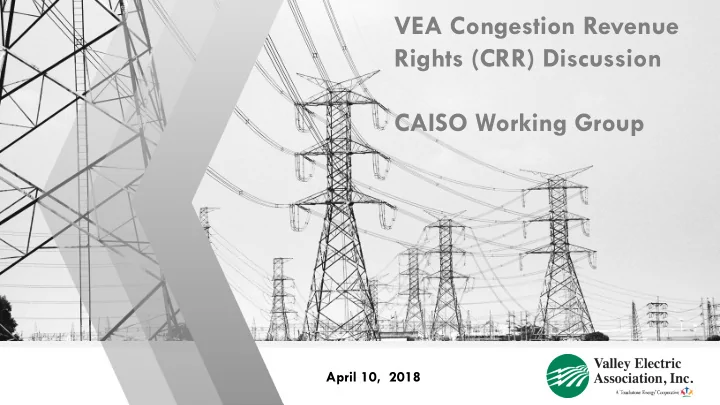

VEA Congestion Revenue Rights (CRR) Discussion CAISO Working Group April 10, 2018
Overview of Points • The CRR auction is vital to VEA’s risk management tools and its ability to serve customers at lowest cost • DMM/SCE proposal would result in an inability for VEA to manage congestion risk and serve its customers at a lower cost • Even a trivial increase in energy delivery prices would more than offset the potential “benefit” of reduced “loss to ratepayers” for VEA and the entire market • Partial funding is another blunt instrument that could in fact worsen the perceived problem trying to be addressed • Benefits from Track 0 changes and improved outage reporting/modeling would be diminished due to the simultaneous implementation of all these “blunt instrument” changes 2
CRRs and Their Impact on VEA • Part of VEA’s decision to join the CAISO Conducted a detailed assessment of the costs and benefits and risks and rewards of joining the CAISO The value of CRRs was a large part in determining the affordability of providing energy to its members under CAISO participation • CRR process is part of VEA’s energy cost management tool bag VEA works to minimize its total cost of load service: What matters to VEA’s member-owners is the all-in cost of service to member-owners CRRs and their value are used by VEA to manage the cost to serve its members CRRs support VEA’s ability to obtain favorable energy delivery and bundled energy & RA supply contracts 3
Why the Auction is Important • Delivery Hedge Perspective Difficult for VEA to compete with the large IOUs for scarce capacity in the allocation process; VEA relies on the • auction to reconfigure its CRR holdings Obtaining the needed hedges would be nearly impossible (or extremely costly) under the DMM/SCE proposal • • Energy Procurement Perspective VEA serves its customers primarily with energy via economy energy purchases • The suppliers are responsible for bringing energy to VEA, or to Mead, which comes from a variety of sources • VEA is aware of the needs of its suppliers to hedge delivery risks • VEA currently spends ~ 10X – 20X its share of DMM’s calculated “CRR Ratepayer Losses” on energy and RA • procurement 4
Why a world without a liquid CRR auction is worse than “the old days” • In the “old days”, under OATT service, VEA or its energy suppliers could work to obtain transmission service under tariff rates Easy to assess lowest cost solution, minimize energy costs, and have cost certainty • • Today, VEA’s service under the nodal market results in market-based congestion costs Exposure to these hourly costs creates risks outside of VEA’s risk management policies/preferences • For its contracted energy & RA products, VEA’s suppliers have to buy the congestion hedge; without a liquid • market this will be more expensive • VEA and its suppliers need CRRs to manage the congestion risk and recognize the nodal market efficiencies • In short, VEA joined the CAISO market because a nodal market with good pricing allows for more efficient transmission buildout, generation siting, and grid management 5
Why a world without a liquid CRR auction is worse than “the old days” (continued) • The nodal market design introduced a tradeoff between a lower TAC and higher congestion CRRs play a vital role in allowing us to accept the higher congestion while still minimizing total costs • Removing CRRs from the market design would no longer leave us with a cost minimizing market due to the • exposure of congestion risk • The ability for us users to tolerate congestion on the grid can afford us a lower TAC by avoiding transmission buildout – suggesting almost an inverse relationship between TAC paying and entitlement to excess congestion rents. This is why it does not make sense that TAC payers directly “deserve” the excess congestion rent • • At the end of the day, VEA and its suppliers need CRRs to manage the nodal congestion risk. With this instrument it allows congestion costs to be manageable while letting us recognize the nodal market efficiencies 6
Partial Funding Haircut to CRR • Partial funding introduces adverse payments impacts to the market Increased shortfalls • Degrades the value of having a CRR and revenue Riskier CRRs product inadequacy • Introduces more risk, thus likely to increase the price of deliveries for VEA • Creates a vicious cycle that would worsen the perceived loss to Reduced CRR Lower CRR auction auction revenues offer prices ratepayers 7
Closing Thoughts • The CRR auction is vital to VEA’s risk management tools and its ability to serve customers at lowest cost • DMM/SCE proposal would result in an inability for VEA to manage congestion risk and serve its customers at a lower cost • Even a trivial increase in energy delivery prices would more than offset the potential “benefit” of reduced “loss to ratepayers” for VEA and the entire market • Partial funding is another blunt instrument that could in fact worsen the perceived problem trying to be addressed • Benefits from Track 0 changes and improved outage reporting/modeling would be diminished due to the simultaneous implementation of all these “blunt instrument” changes 8
Questions 9
Recommend
More recommend